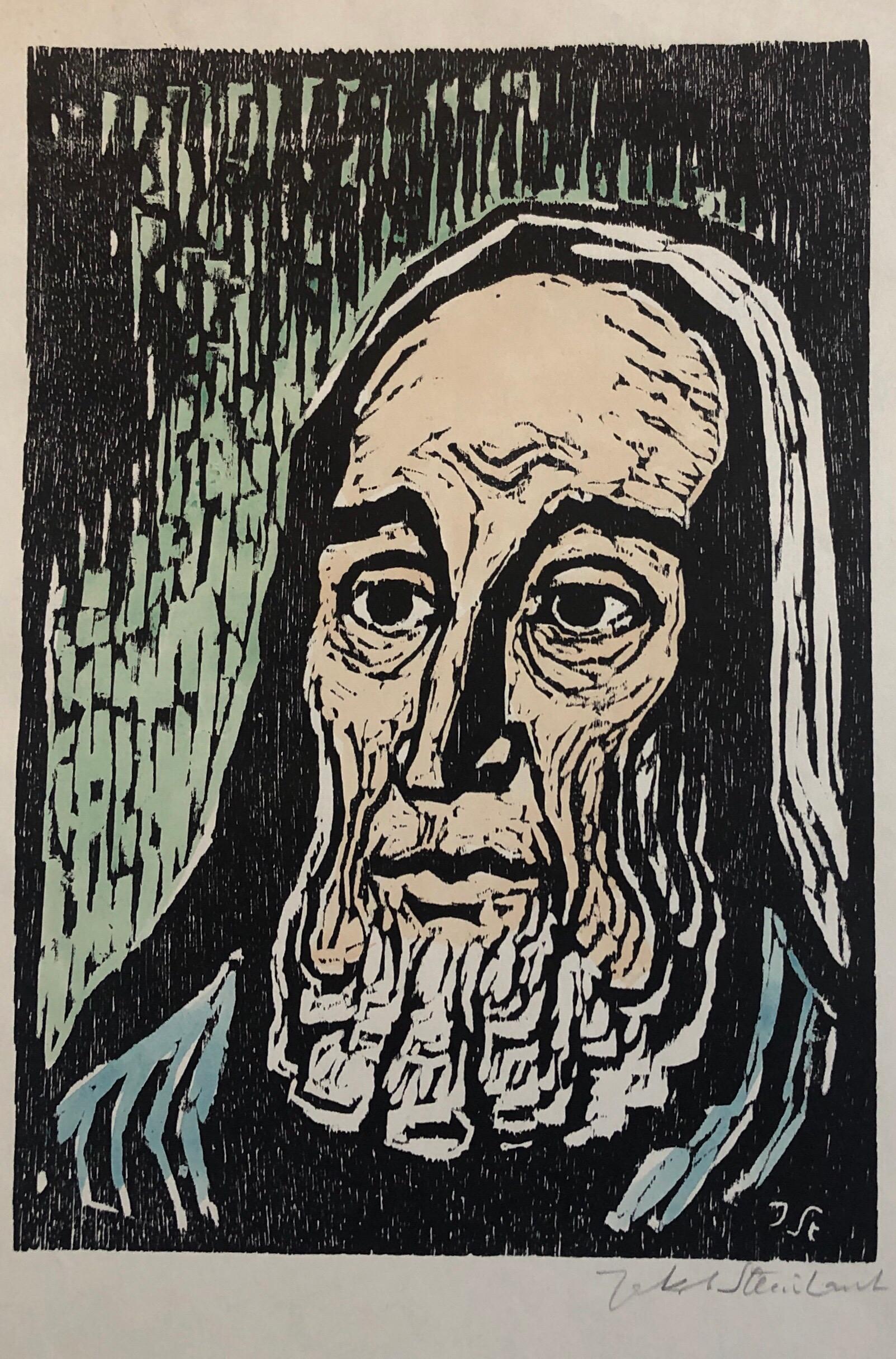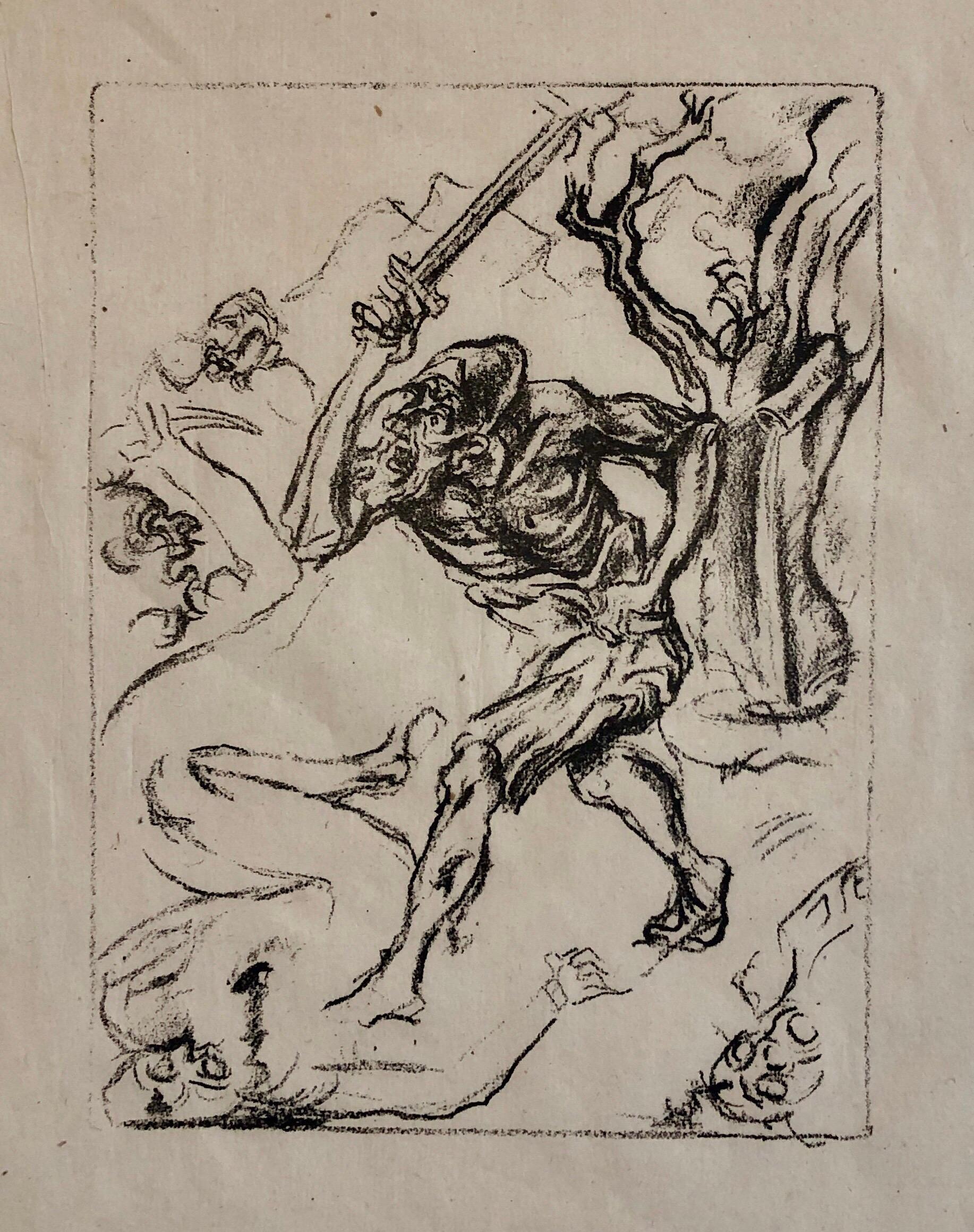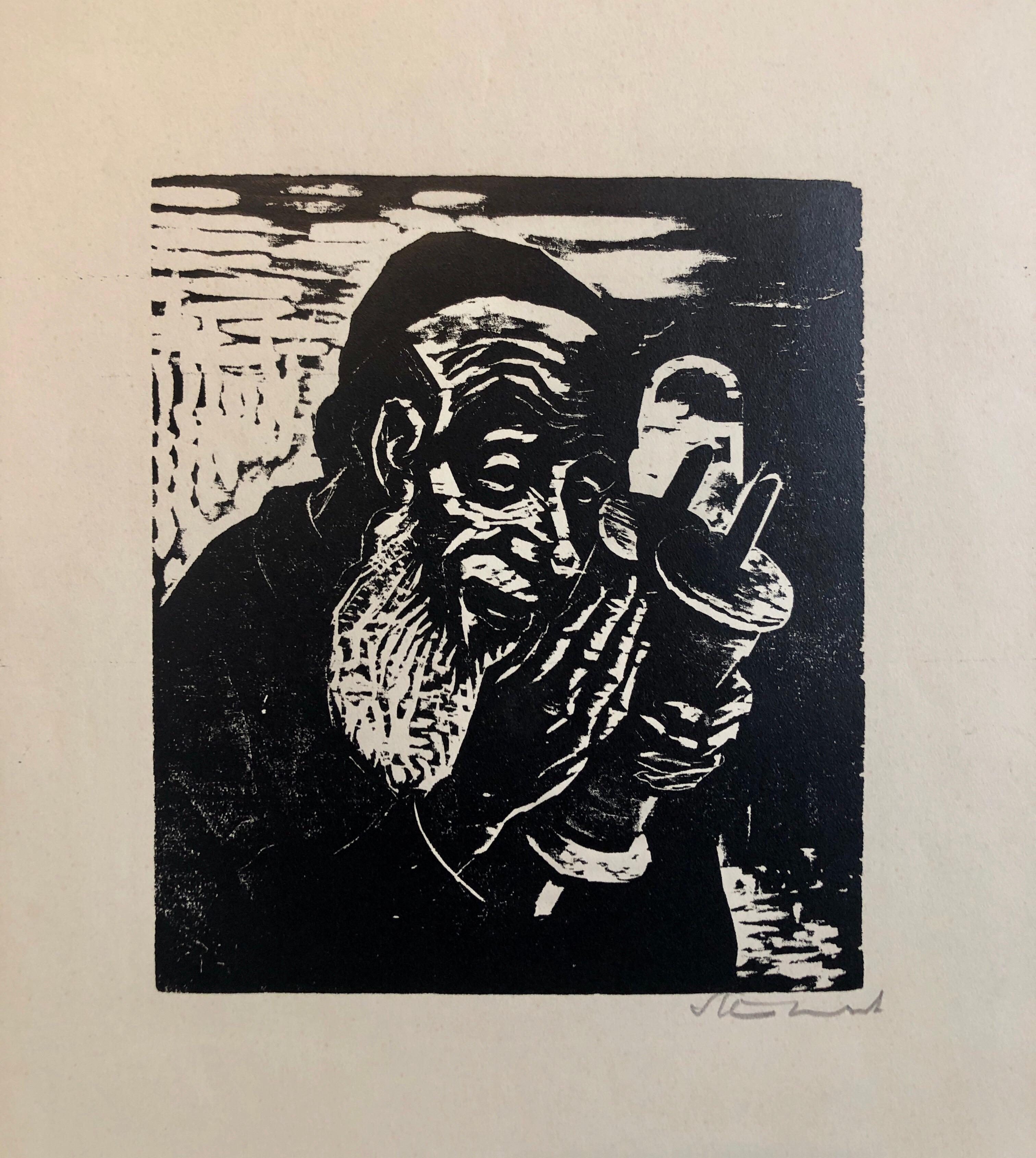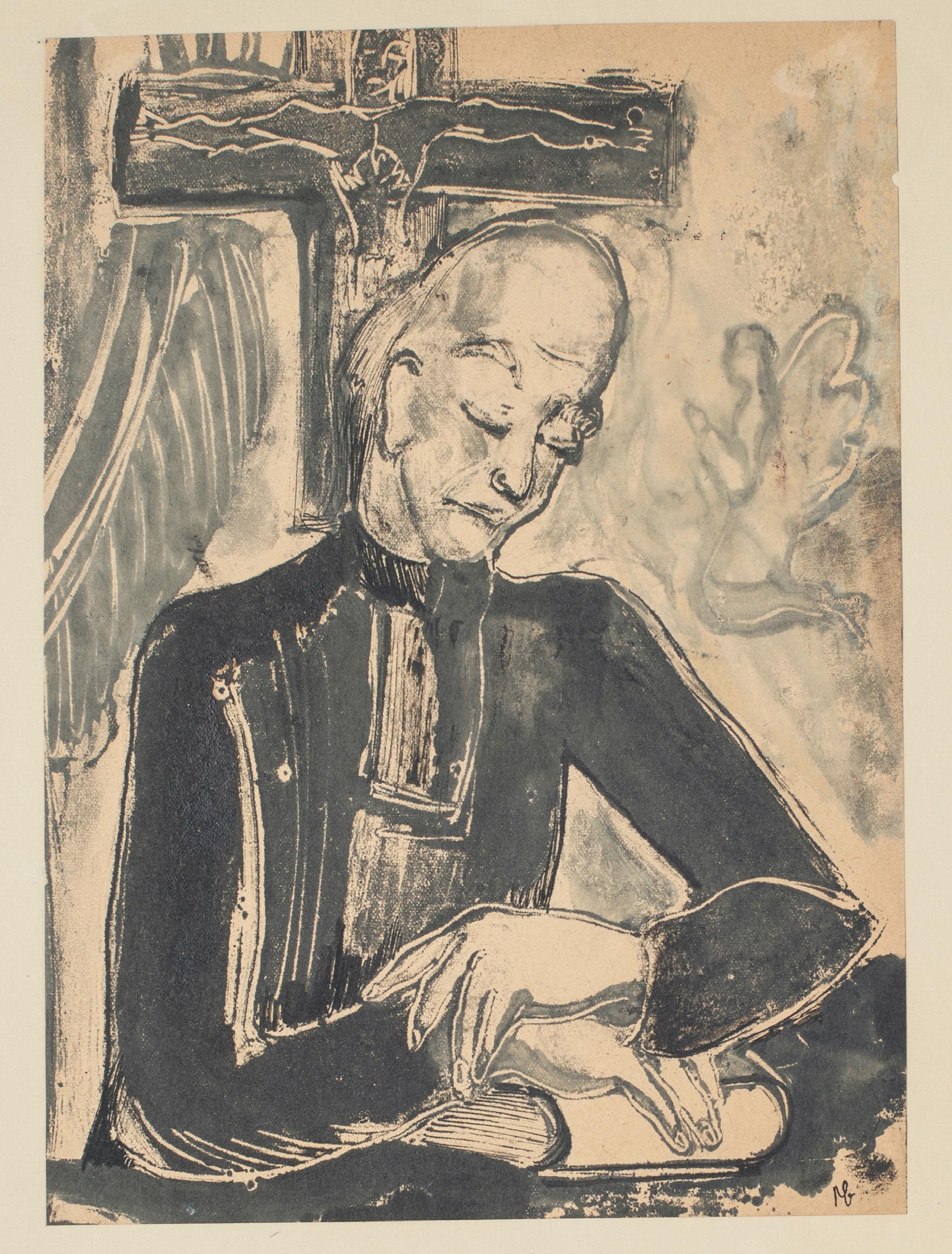Items Similar to Steinhardt Woodcut Marian Anderson Signed African American, Israeli Bezalel Art
Want more images or videos?
Request additional images or videos from the seller
1 of 12
Jacob SteinhardtSteinhardt Woodcut Marian Anderson Signed African American, Israeli Bezalel Art1959
1959
About the Item
Portrait in black and white, woodblock print. Pencil signed by both Jacob Steinhardt 1887-1968 and Marian Anderson. Very rare thus. (Commissioned by Dr. Leon Kolb, San Francisco)
35.8 x 23.6 cm (image)
Marian Anderson is remembered as one of the best American contraltos (women with lower singing voices) of all time. She was the first African American singer to perform at the White House and the first African American to sing with New York's Metropolitan Opera.
Marian Anderson was born in Philadelphia, Pennsylvania, on February 27, 1897. She was educated in the public schools. She displayed a remarkable skill for singing when she was very young, and she loved singing for her church choir. When she could not afford singing lessons, her fellow choir members raised the money that allowed her to study with a famous singing teacher.
When Anderson was twenty-three years old, she entered a competition and won first place over three hundred other singers. The prize was the opportunity to sing with the New York Philharmonic orchestra. Further sponsorships enabled her to continue her studies in both the United States and in Europe.
Following Anderson's debuts (first performances on stage in a particular city) in Berlin, Germany, in 1930 and London, England, in 1932, she performed in Scandinavia (northern Europe), South America, and the Soviet Union. In Salzburg, Austria, she gave a sensational performance. The famous conductor Arturo Toscanini (1867–1957) was in the audience. After hearing her sing, Toscanini said she had "a voice heard but once in a century."
At the end of Anderson's European tour, she was signed to a contract for fifteen concerts in the United States. On December 30, 1935, she opened her American tour at New York's Town Hall. She performed pieces by European classical composers as well as several African American spirituals (traditional religious songs). The performance was a great success. Critics welcomed her as a "new high priestess of song." In the words of a writer for the New York Times, the concert established her as "one of the great singers of our time."
Over the next several years Anderson sang for U.S. president Franklin Delano Roosevelt (1882–1945) at the White House and for Great Britain's King George VI (1895–1952) during his 1939 visit to the United States. After World War II (1939–45; a war fought between Great Britain, France, the Soviet Union, and the United States against Germany, Italy, and Japan) ended, she performed in major European cities again. By 1950 it was estimated that she had performed before nearly four million listeners.
Anderson was a pioneer in winning recognition at home and abroad for African American artists. In 1939 an incident involving the Daughters of the American Revolution (DAR) helped focus public attention on racism. The DAR denied Anderson use of their Constitution Hall in Washington, D.C., for an April concert. First Lady Eleanor Roosevelt resigned from the DAR in protest and had the U.S. government allow Anderson to perform at the Lincoln Memorial. Her concert there, on Easter morning, drew a live audience of seventy-five thousand, and millions more heard it over the radio.
Among the people influenced by the concert was 10-year-old Martin Luther King, Jr. Five years later, King won a speaking contest at his Atlanta high school, using the topic “The Negro and the Constitution,” and mentioning the event. As a high school junior, King said: “She sang as never before with tears in her eyes. When the words of ‘America’ and ‘Nobody Knows De Trouble I Seen’ rang out over that great gathering, there was a hush on the sea of uplifted faces, black and white, and a new baptism of liberty, equality and fraternity. That was a touching tribute, but Miss Anderson may not as yet spend the night in any good hotel in America.”
In 1955, and again in 1956, Anderson sang in an opera at New York's Metropolitan Opera House. This was the first time an African American had sung with the Metropolitan since it opened in 1883. Over the years Anderson continued to add to her accomplishments. She sang at the presidential inaugurations of Dwight D. Eisenhower (1890–1969) and John F. Kennedy (1917–1963). In 1957 Anderson made a concert tour of India and the Far East for the U.S. State Department. In 1958 President Eisenhower appointed her a delegate (representative) to the Thirteenth General Assembly of the United Nations (UN). She was awarded the UN Peace Prize in 1977. Anderson gave her farewell concert (last public performance) at Carnegie Hall in New York on Easter Sunday in 1965. She died on April 8, 1993, in Portland, Oregon.
Steinhardt, Jakob, Painter and Woodcut Artist. b. 1887, Yaacov Steinhardt was born in the then remote, largely Polish town of Zerkow in the Posen District of Germany. (poland/german) Immigrated 1933. Studies: 1906 School of Art, 1906 Studied in Berlin Arts and Crafts School. Berlin; 1907 painting with Lovis Corinth and engraving and etching with Hermann Struck; advanced studies, 1908-10 Paris, with Henri Matisse and Steinlen; 1911 Italy. Teaching: Bezalel, Jerusalem, 1953-57 Director. 1910 Participated in the “New Sezession”, Berlin. 1912 together with Ludwig Meidner and Janthur he founded the "Pathetiker" group very early in the German expressionist movement. Running afoul of the Nazis, he fled to Tel-Aviv and then Jerusalem in the early 30s, showing in “Der Sturm” Gallery. 1914 Exhibited with ludwig Meidner at first Expressionist Exhibition in Berlin. Worked mainly in woodcuts depicting biblical and other Jewish subjects. 1955-58 International awards for his woodcuts. receives graphic commissions from Fritz Gurlitt. 1922 Marries Minni Gumpert. Active in organizing Secession exhibits. 1925 Trips to Mark Brandenburg and Holy Land. Turns primarily to painting; stops work on etchings and lithographs. 1933 Emigrates to the Palestine. 1934 Moves to Jerusalem and opens an art school; attempts some etchings. 1948 Closes the art school and becomes Chairman of Graphics Department, Bezalel School for Arts and Crafts. 1954-57 Director of Bezalel School for Arts and Crafts. Taken up by J. B. Neumann who became the agent for his etchings. Exhibited Sturm Gallery, Herbst-salon. 1914 Outbreak of World War I; Steinhardt enlists in German army. 1916-18 First on Eastern Front in Poland and Lithuania, then after short training period in Berlin, sent to Macedonia. 1917 Exhibition of Lithuanian drawings at Berlin Secession in Spring. Elected member of the Secession.
He often used wood-cutting techniques that were popular amongst German Expressionists. Steinhardt was driven to express ideas clearly and decisively through art.
Amongst the themes found in his work the prophets of the Bible, such as Jonah, are noticeable. Steinhardt identified deeply with Jonah due to his attempt to run from God's call to duty.
Additionally, the image of beggars was often found in Steinhardt's works and in his artistic presentation of the less fortunate, the artist's love for his fellow man becomes evident.
Moreover, the grotesque was a theme noticeable in Steinhardt's earliest pieces. These were fantastical images; it was unclear whether or not they were human or demon. In the 1950's, Steinhardt returned to these images upon learning of the Holocaust of Europe's Jews. At that time he resided in New York and there, in the shadow of the skyscrapers, Steinhardt's reaction to WWII was expressed through his art.
A Collection of Works by Artists of the Land of IsraelThe Bezalel National Museum, Jerusalem 1940 Artists: Shemi, Menahem Rubin, Reuven Avni, Aharon Mokady, Moshe Jonas, Ludwig Steinhardt, Jakob Ticho, Anna Krakauer, Leopold Gutman, Nachum Budko, Joseph Ardon, Mordecai Sima, Miron Castel, Moshe Pann, Abel Struck, Hermann Gur Arie, Meir Ben Zvi, Zeev Litvinovsky, Pinchas
Education
1906 Berlin Art Museum, Berlin
1907 painting with Louis Corinth and engraving with Hermann Struck, Berlin
1909-1910 Académie Julian, Paris
1909-1910 Académie Colarossi, Paris
1909-1910 Académie Matisse, Paris
Teaching
1934-1949 Instructor drawing, painting and printing, The Studio
1949-1957 Instructor, New Bezalel, Jerusalem
1949-1953 Head of graphics department, New Bezalel, Jerusalem
1953-1957 Director, Bezalel Academy of Arts and Design, Jerusalem
Awards And Prizes
1939 IBM prize, New York World's Fair, New York, USA
1955 First Prize, Sao Paolo Biennale, Brazil
1958 California Print Makers Prize, San Francisco, USA
1959 Arte Liturgica Prize, Venice Biennale, Italy
1961 Arte Sacra Prize, The International Biennial for Religious Art, Trieste, Italy
- Creator:Jacob Steinhardt (1887 - 1968, Israeli)
- Creation Year:1959
- Dimensions:Height: 22.75 in (57.79 cm)Width: 14.25 in (36.2 cm)Depth: 0.1 in (2.54 mm)
- Medium:
- Movement & Style:
- Period:
- Condition:good. image measures 35.8 x 23.6 cm. original matting has light creasing, minor wear.
- Gallery Location:Surfside, FL
- Reference Number:1stDibs: LU3824506391
About the Seller
4.9
Platinum Seller
These expertly vetted sellers are 1stDibs' most experienced sellers and are rated highest by our customers.
Established in 1995
1stDibs seller since 2014
1,541 sales on 1stDibs
Typical response time: 1 hour
- ShippingRetrieving quote...Ships From: Surfside, FL
- Return PolicyA return for this item may be initiated within 3 days of delivery.
More From This SellerView All
- Jewish Prophet Rabbi German Expressionist Color Woodcut Israeli Early BezalelBy Jacob SteinhardtLocated in Surfside, FLHand signed in pencil, colored woodcut. Jacob Steinhardt 1887-1968 Steinhardt, Jakob, Painter and Woodcut Artist. b. 1887, Yaacov Steinhardt was born in the then remote, largely...Category
20th Century Expressionist Figurative Prints
MaterialsWoodcut
- Jakob Steinhardt Jewish German Expressionist Lithograph Israeli Early BezalelBy Jacob SteinhardtLocated in Surfside, FLplate signed. Jacob Steinhardt 1887-1968 Steinhardt, Jakob, Painter and Woodcut Artist. b. 1887, Yaacov Steinhardt was born in the then remote, largely Polish town of Zerkow in the Posen District of Germany. (poland/german) Immigrated 1933. Studies: 1906 School of Art, 1906 Studied in Berlin Arts and Crafts School. Berlin; 1907 painting with Lovis Corinth and engraving and etching with Hermann Struck; advanced studies, 1908-10 Paris, with Henri Matisse and Steinlen; 1911 Italy. Teaching: Bezalel, Jerusalem, 1953-57 Director. 1910 Participated in the “New Sezession”, Berlin. 1912 together with Ludwig Meidner and Janthur he founded the "Pathetiker" group very early in the German expressionist movement. Running afoul of the Nazis, he fled to Tel-Aviv and then Jerusalem in the early 30s, showing in “Der Sturm” Gallery. 1914 Exhibited with ludwig Meidner at first Expressionist Exhibition in Berlin. Worked mainly in woodcuts depicting biblical and other Jewish subjects. 1955-58 International awards for his woodcuts. receives graphic commissions from Fritz Gurlitt. 1922 Marries Minni Gumpert. Active in organizing Secession exhibits. 1925 Trips to Mark Brandenburg and Holy Land. Turns primarily to painting; stops work on etchings and lithographs. 1933 Emigrates to the Palestine. 1934 Moves to Jerusalem and opens an art school; attempts some etchings. 1948 Closes the art school and becomes Chairman of Graphics Department, Bezalel School for Arts and Crafts. 1954-57 Director of Bezalel School for Arts and Crafts. Taken up by J. B. Neumann who became the agent for his etchings. Exhibited Sturm Gallery, Herbst-salon. 1914 Outbreak of World War I; Steinhardt enlists in German army. 1916-18 First on Eastern Front in Poland and Lithuania, then after short training period in Berlin, sent to Macedonia. 1917 Exhibition of Lithuanian drawings at Berlin Secession in Spring. Elected member of the Secession. He often used wood-cutting techniques that were popular amongst German Expressionists. Steinhardt was driven to express ideas clearly and decisively through art. Amongst the themes found in his work the prophets of the Bible, such as Jonah, are noticeable. Steinhardt identified deeply with Jonah due to his attempt to run from God's call to duty. Additionally, the image of beggars was often found in Steinhardt's works and in his artistic presentation of the less fortunate, the artist's love for his fellow man becomes evident. Moreover, the grotesque was a theme noticeable in Steinhardt's earliest pieces. These were fantastical images; it was unclear whether or not they were human or demon. In the 1950's, Steinhardt returned to these images upon learning of the Holocaust of Europe's Jews. At that time he resided in New York and there, in the shadow of the skyscrapers, Steinhardt's reaction to WWII was expressed through his art. A Collection of Works by Artists of the Land of IsraelThe Bezalel National Museum, Jerusalem 1940 Artists: Shemi, Menahem Rubin...Category
20th Century Expressionist Figurative Prints
MaterialsWoodcut
- Jewish Rabbi with Torah German Expressionist Woodcut Israeli Early BezalelBy Jacob SteinhardtLocated in Surfside, FLHand signed in pencil, woodblock print woodcut. Jacob Steinhardt 1887-1968 Steinhardt, Jakob, Painter and Woodcut Artist. b. 1887, Yaacov Steinhardt was born in the then remote,...Category
20th Century Expressionist Figurative Prints
MaterialsWoodcut
- Lithograph Israeli Modernist Judaica, Kibbutz Boy, Bezalel ArtistBy Moshe GatLocated in Surfside, FLA signed and numbered lithograph print. Moshe Gat was born in Haifa in 1935. in 1952 he began his studies at the Bezalel School, in Jerusalem. In 1955 he returned to Haifa, where h...Category
Mid-20th Century Expressionist Figurative Prints
MaterialsLithograph
- Dutch Fantastic Modern Etching, Jan Mensinga Old Master Style Wine Maker, GrapesLocated in Surfside, FLJan Roelf Mensinga, Dutch artist, painter, graphic printmaker, watercolor artist. (born Leeuwarden 1924 - 1998 Amsterdam) Education: Mensinga attended an art studies from 1954 to 1...Category
20th Century Expressionist Figurative Prints
MaterialsEtching
- Screenprint Serigraph Art Print WPA Artist NYC Frank Kleinholz Children PlayingBy Frank KleinholzLocated in Surfside, FLFrank Kleinholz (Brooklyn, 1901 - 1987) 1963 Children playing in park Screenprint, serigraph Born in Brooklyn, New York, Frank Kleinholz was a painter based in New York City whose work spanned several art movements including Expressionism and Social Realism. His work was strongly influenced by Max Beckmann, is a late survival of the social commentary expressionism of the WPA era; His early lithograph works were intensely personal and reflected the influence of the Depression and the World Wars, but his palette lightened as he increasingly focused on families and the bonds between adults and children. He was contemporary of William Gropper and Ben Shahn. As the son of a blind father and hard-working mother who supported the family with a delicatessen. From early childhood, he had to earn a living and sold newspapers and ran errands for local businesses. He graduated from Fordham Law School, and at age 23 was admitted to the bar. In the mid-1930s, while practicing insurance as well as law, he began oil painting and printmaking with teachers including Yasuo Kuniyoshi and Sol Wilson. He gained quick recognition and between 1941 and 1980 participated in numerous exhibitions including the National Academy of Design, the Brooklyn Museum and the Worcester Art Institute. Born in Brooklyn, New York, Kleinholz graduated Fordham Law School in 1923. In the 1930s, he began studying painting under Yasuo Kuniyoshi and Sol Wilson. He quickly rose to prominence with the inclusion of Abstract art in the Carnegie Institute exhibition of 1941. His painting Backstreet won a purchase prize by the Metropolitan Museum of Art. Chronology His strongest influences were American Social Realists Reginald Marsh and Philip Evergood, the German Expressionists George Grosz and Kathe Kollwitz, the Mexican muralists Diego Rivera, Jorge Orozco, and David Alfaro Siqueiros, and the early 20th century Paris Modernists. Described by Newsweek as a "Brooklyn-born Gauguin," Kleinholz focused on urban life in New York, Brooklyn and Coney Island, as well as intimate, social realist scenes of parents and children, watercolor paintings of flowers and birds, and sunbathers. His political works include anti war paintings...Category
20th Century Expressionist Figurative Prints
MaterialsWatercolor, Lithograph
You May Also Like
- Men - Pair of Original Monotype Woodcuts - Mid 1900Located in Roma, ITMen is a pair of two original monotype woodcuts realized by an Anonymous artist of the XX century, in 1950 ca, glued on paper. In very good condition. Image dimension : 26 x 19.5 c...Category
Mid-20th Century Expressionist Portrait Prints
MaterialsWoodcut
- Félix Vallotton ( Swiss 1865 - 1925) L’Exécution Woodcut 18/25 , SwitzerlandBy Félix VallottonLocated in Meinisberg, CHFélix Vallotton (Swiss, 1865 - 1925) L’Exécution • Wood cut print • Loose Japan paper sheet, 25 x 37 cm • Block, ca. 15 x 25 cm • Monogrammed in the ...Category
1890s Expressionist Figurative Prints
MaterialsPaper, Ink, Woodcut
- Original Vintage Secession Poster celebrating the emperor's jubileeLocated in Zurich, CHOriginal Vintage Poster by the Austrian artist Ferdinand Ludwig Graf, a member of the Hagenbund. This Viennese artist association moved as soon a...Category
Early 1900s Vienna Secession Figurative Prints
MaterialsPaper
- Marc Chagall - Four Tales from the Arabian Nights - COMPLETE SET (12)By Marc ChagallLocated in Los Angeles, CAMarc Chagall (1887-1985) FOUR TALES FROM THE ARABIAN NIGHTS (MOURLOT 36 - 47; CRAMER BOOKS 18) The complete set of twelve lithographs printed in co...Category
Mid-19th Century Expressionist Figurative Prints
MaterialsLithograph, Laid Paper
- Repos, 1999, original lithograph by Jean Jansem handsigned numberedBy Jean JansemLocated in Carouge GE, GEJean Jansem (1920-2013) Repos, Album Danse, 1999 Lithographie sur papier Arches Signée et justifiée 50 x 65 cm / 54 x 76 cm Imprimeur: Mourlot, Paris Editeur: Jansem, Paris Bibliographie: Jansem Lithographe, 1993-1999, Flora Jansem, Paris, n. 155, reproduit p.81, référencé p. 97. "Ma première lithographie date de 1954. Elle représente un enfant en haillons portant deux seaux d'eau, d'après un croquis rapporté de Cordoue lors de mon voyage en Espagne en 1952. Je l'exécutai sur pierre, au pinceau et à l'encre lithographique. Je fus déçu du résultat et n'en tirai qu'un essai et une épreuve. Quatre ans plus tard, je réalisai une dizaine de nouvelles lithographies, toujours sur pierre, la plupart en noir. Au lieu d'employer l'encre et le crayon lithographiques, j'utilisai l'encre zincographique plus fluide me permettant de travailler à la plume ou avec de fins pinceaux de martre. Le tirage fut très satisfaisant. au grand étonnement du Père Guillard, lithographe. Jusqu'alors l'encre zincographique ne servait qu'à la zincographie. Actuellement elle est d'un usage courant puisque pratiquement toutes les lithographies se font sur zinc et non plus sur pierre, ce qui facilite la manipulation. Par ailleurs, le zinc offre autant de possibilités que la pierre. En 1959, La Guilde de la Gravure me demanda une édition en couleur. Je choisis une nature morte aux chardons, tirée à 220 exemplaires. Par la suite, les tirages varièrent de 10 à 160 épreuves. Mes lithographies en couleur étaient assez proches de mes toiles. A partir de 1968, période de La Danse, je supprimai petit à petit le clair-obscur et la matière pour donner plus de légèreté et de transparence. Les lithographies postérieures à 1970 sont dessinées en noir sur un fond coloré souvent volontairement arbitraire, donnant l'aspect d'un dessin rehaussé. La couleur n'est pas intégrée au dessin mais joue un rôle d'accompagnement du trait qui est lui-même une arabesque écrite. Quand le noir...Category
Late 20th Century Expressionist Figurative Prints
MaterialsLithograph
- Danseuse assise de dos au tabouret, 1999, original lithograph signed Jean JansemBy Jean JansemLocated in Carouge GE, GEJean Jansem (1920-2013) Sonia fond jaune, 1995 Lithographie sur papier Arches Signée en bas à droite et justifiée en bas à gauche 67 x 51,5 cm / 76 x 56 cm Rare exemplaire d'une é...Category
Late 20th Century Expressionist Figurative Prints
MaterialsLithograph
Recently Viewed
View AllMore Ways To Browse
Anderson Design
Retro Welcome Sign
Holocaust Art
Israeli Women
South African Drawing
Philadelphia Arts And Crafts
Jacob George
B King Art Work
African Wood Head
African American Man Portrait
Japanese Arts And Craft Period
British India Prints
Georges Israel
Jewish Religious Art
Woodblock Print European
1950 Radio
German Art Hermann
Black White Woodblock





